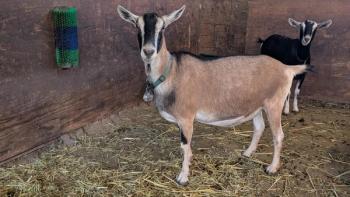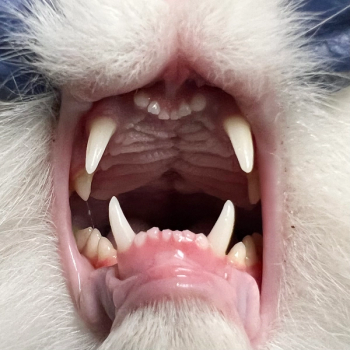
Surgery STAT: The finer points of laparoscopic liver biopsies
Less pain and a quicker recovery than a traditional laparotomy. Your veterinary patients will thank you, or at least give you a tail wag.
When you suspect hepatic disease in a patient, a liver biopsy is indicated to obtain a definitive diagnosis. A histopathologic diagnosis can help you differentiate among and guide treatment of neoplastic, infectious, inflammatory and metabolic conditions within the liver.
Traditional methods of obtaining a diagnosis have included percutaneous fine-needle aspiration, ultrasound-guided percutaneous biopsy or laparotomy.1 The use of laparoscopic equipment allows for traditionally open surgical procedures to be performed with minimally invasive techniques, resulting in less postoperative pain and faster recovery.2,3 More specifically, laparoscopic liver biopsy is now a useful procedure that results in diagnostic histopathologic samples and minimal morbidity to the patient.
Required equipment
- A laparoscopic tower (monitor, camera, light source, insufflator and carbon dioxide canister)
- A 5-mm telescope (0 or 30 degrees)
- 1 to 2 trocar cannulas
- A laparoscopic biopsy instrument (often a cup biopsy forceps)
Additional laparoscopic instruments (such as a blunt probe and liver fan) may be useful for manipulation of abdominal organs and ideal visualization.
Patient considerations
Factors such as diaphragmatic hernia, significant ascites or large solitary liver masses may be considered reasons to elect an alternative method of diagnosis. Appropriate abdominal insufflation is necessary (maximum of 15 mm Hg intra-abdominal pressure), which may result in respiratory difficulty and necessitate mechanical ventilation. Additionally, appropriate preanesthetic testing (complete blood count, serum chemistry profile, urinalysis and coagulation profile) as clinically indicated should be performed, and specific patient risk factors should be assessed. Before the procedure, always discuss with the client the possibility of needing to convert to an open laparotomy because of equipment failure, poor visualization or patient complications.
Patient preparation
Place the patient in dorsal recumbency. I prefer to have the patient tilted in a cranial-caudal position (head slightly elevated). Prep the patient's abdomen in a standard fashion in case conversion to an open laparotomy is necessary. Use a standard four-point draping method.
Procedure
Insufflate the abdomen using a Veress needle or Hasson technique-whichever you prefer. (Briefly, a Veress needle involves using a specially constructed needle to penetrate the abdomen and insufflate the abdomen before trocar placement, while the Hasson technique requires dissection through the body wall and placement of the first trocar with a blunt obturator.)
Figure 1. Placement of a trocar just caudal to the umbilicus for insertion of a 5-mm telescope. (Figures courtesy of Dr. Marc Hirshenson)
Insert a single trocar port along midline just caudal to the umbilicus (Figure 1). Once the abdomen is insufflated, insert the telescope to visualize the abdominal organs. Depending on your preference, a single multi-trocar port can be used for instrumentation, or a second port can be created more cranially for instrumentation. While some surgeons prefer to place the second port to the right or left off midline, I prefer placement of the second port along midline to minimize bleeding and discomfort from the abdominal wall musculature.
Under telescope visualization and using a laparoscopic biopsy instrument, obtain samples (Figures 2-4). I use a technique of grasping a piece of tissue, waiting 10 to 15 seconds and then pulling the sample in a twisting motion. Obtaining several samples from different lobes is recommended.
Figure 2. Using a blunt probe to isolate and visualize the desired liver lobes.
Figure 3. Using a laparoscopic cup forceps to obtain a sample from lobe periphery.
Figure 4. The biopsy site immediately after procurement of the laparoscopic liver biopsy sample, showing mild post-sample hemorrhage.
While sampling the periphery of liver lobes is easier, it is possible to obtain more centrally located samples, as well. The placement of a small piece of hemostatic agent through the instrument port at the site of liver biopsy can be considered to assist clot formation. Appropriate clotting can typically be visualized during the procedure.
Process the samples for submission for histopathologic analysis or culture as appropriate. Remove the instrument and camera, evacuate the carbon dioxide manually from the abdominal cavity, and close the abdominal wall, subcutaneous tissues and skin routinely.
Postoperative care
Perform standard postoperative care including pain medication and supportive care. Tell owners to care for the incision just the same as you would for an open laparotomy. Depending on the patient and client, performing the procedure on an outpatient basis can be considered. Postoperative complications could include hemorrhage, pain, nausea or infection and should be monitored for and treated as appropriate.
Conclusion
Laparoscopic liver biopsy is a technically simple procedure once you have been trained appropriately in the use of laparoscopic equipment. It results in excellent visualization of the liver and procurement of diagnostic samples with less morbidity than traditional open surgical techniques.
References
1. McDevitt HL, Mayhew PD, Giuffrida MA, et al. Short-term clinical outcome of laparoscopic liver biopsy in dogs: 106 cases (2003-2013). J Am Vet Med Assoc 2016;248:83-90.
2. Devitt CM, Cox RE, Hailey JJ. Duration, complications, stress, and pain of open ovariohysterectomy versus a simple method of laparoscopic-assisted ovariohysterectomy in dogs. J Am Vet Med Assoc 2005;227:921-927.
3. Culp WT, Mayhew PD, Brown DC. The effect of laparoscopic versus open ovariectomy on postsurgical activity in small dogs. Vet Surg 2009;38:811-817.
Dr. Marc Hirshenson is an ACVS board-certified veterinary surgeon practicing at Gold Coast Center for Veterinary Care and West Hills Animal Hospital and Emergency Center in Huntington, New York. Aside from his experience with minimally invasive surgery, his professional interests include surgical oncology, wound management and cruciate ligament disease. In his spare time, he enjoys running, swimming, relaxing on the beach and traveling with his wife.
Newsletter
From exam room tips to practice management insights, get trusted veterinary news delivered straight to your inbox—subscribe to dvm360.






